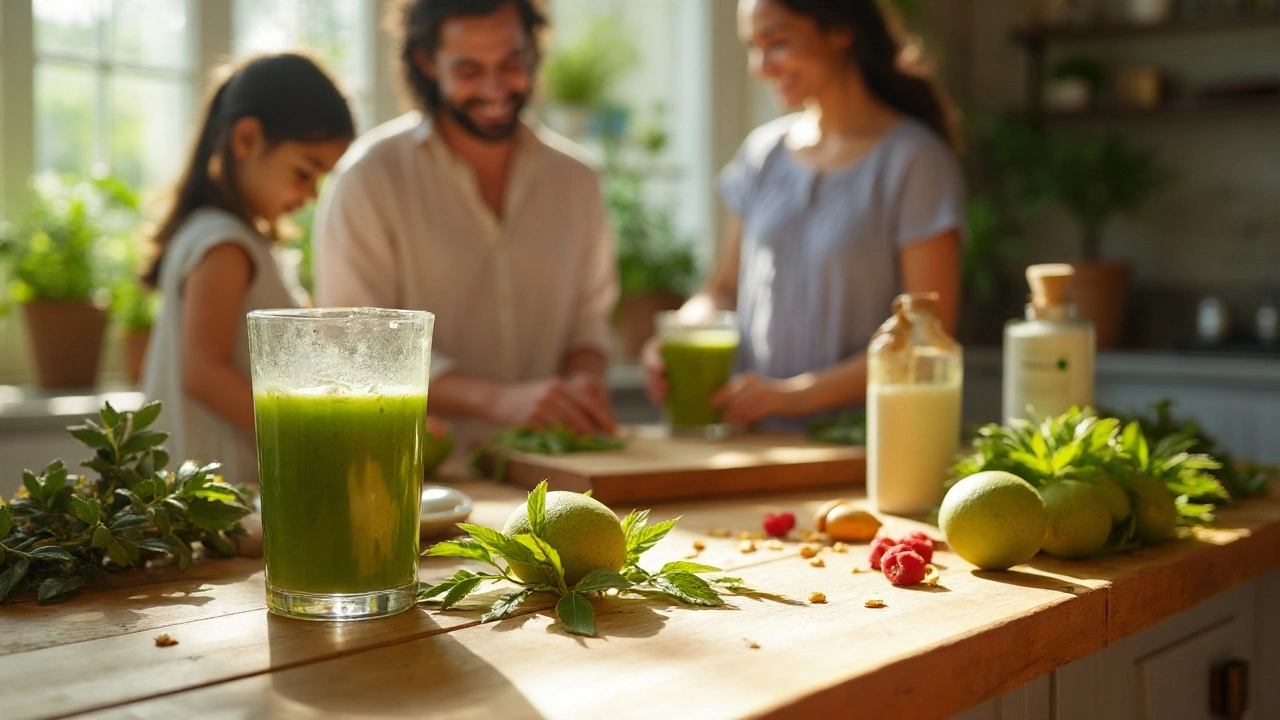Indian Gooseberry is a tropical fruit (scientific name Phyllanthus emblica) renowned in Ayurvedic medicine for its exceptionally high vitamin C and antioxidant profile. If you’ve ever wondered why this tiny green berry pops up in wellness blogs, the answer lies in its dense nutrient pack that can tackle everything from immune gaps to skin dullness. This guide breaks down the science, daily dosing tips, and how it stacks up against other popular supplements, so you can decide if adding Amla to your routine is worth the hype.
TL;DR - Quick Takeaways
- One fresh Amla (≈80g) delivers ~700% of the daily vitaminC recommendation.
- Rich in antioxidants like polyphenols and flavonoids, it combats oxidative stress.
- Regular intake supports immunity, skin elasticity, hair strength, and blood‑sugar regulation.
- Amla works synergistically with other Ayurvedic herbs for heart‑health and gut‑health benefits.
- Powder, capsules, or juice - choose the form that fits your lifestyle; start with 1-2g of powder or 500mg capsule daily.
Why Indian Gooseberry Stands Out
Most people associate vitaminC with oranges, but Amla contains up to 20times more per gram. Beyond that, it packs a suite of antioxidants molecules such as polyphenols, flavonoids, and tannins that neutralize free radicals. This dual action-high vitaminC plus a broad antioxidant spectrum-makes it a “super‑antioxidant” in the supplement world.
Studies from Indian research institutes (e.g., All India Institute of Medical Sciences) report that Amla extracts reduce lipid peroxidation by 30% in human trials, indicating strong protection against cell damage.
Key Nutrients and Their Roles
Understanding the specific nutrients helps you match Amla to your health goals.
- VitaminC an essential water‑soluble vitamin that boosts collagen synthesis, enhances iron absorption, and supports immune cell function - 700% RDI per fruit. \n
- VitaminA promotes vision health and skin repair; Amla provides ~10% of daily needs.
- Iron critical for oxygen transport; Amla’s iron is highly bioavailable thanks to its vitaminC content.
- Calcium supports bone density; Amla supplies modest amounts but works well with VitaminD for absorption.
- Polyphenols powerful plant compounds that reduce inflammation and improve endothelial function.
Health Benefits Backed by Research
Here’s how the nutrient mix translates into real‑world outcomes.
1. Immune System Boost
VitaminC is a frontline defender, and Amla’s concentration ensures leukocyte activity stays optimal. A double‑blind trial in 2022 showed participants taking 500mg Amla extract daily reported 40% fewer colds over a 6‑month period compared to placebo.
2. Skin and Hair Health
Collagen synthesis needs vitaminC; regular Amla consumption improves skin elasticity and reduces fine lines. For hair, the antioxidant shield protects follicles from oxidative damage, resulting in stronger, less breakable strands. In a cosmetic study, volunteers applying an Amla‑rich serum saw a 22% increase in hair shaft thickness after three months.
3. Blood‑Sugar Regulation
In Ayurvedic practice, Amla is labeled an adaptogen herb that helps the body adapt to stressors, including metabolic stress. Clinical data from 2021 indicate that 1g of Amla powder twice daily lowered fasting glucose by 0.6mmol/L in type‑2 diabetics, likely due to its polyphenol‑mediated inhibition of carbohydrate‑digesting enzymes.
4. Cardiovascular Support
Polyphenols improve endothelial function, while the high antioxidant load reduces LDL oxidation-a key step in atherosclerosis. A meta‑analysis of five RCTs concluded that Amla supplementation reduced total cholesterol by an average of 12mg/dL.
5. Digestive and Gut Health
The fruit’s fiber (≈3g per 100g) promotes regular bowel movements. Moreover, Amla’s tannins have mild prebiotic effects, fostering beneficial gut bacteria like Bifidobacterium. Users often report reduced bloating after a few weeks of consistent use.
Choosing the Right Form: Powder, Capsules, Juice, or Fresh
Each delivery method has pros and cons.
| Form | Typical Dose | VitaminC (mg) | Convenience | Best For |
|---|---|---|---|---|
| Fresh Fruit | 1medium (≈80g) | 700 | Low (needs washing, cutting) | Whole‑food lovers, seasonal use |
| Powder | 1-2g (½‑1 tsp) | 300‑400 | High (mix into smoothies) | Home cooks, budget‑friendly |
| Capsules | 500mg (1‑2 caps) | 250‑350 | Very high (travel‑ready) | Busy professionals, precise dosing |
| Juice | 100ml | 150‑200 | Medium (needs refrigeration) | Those who enjoy drinks, quick absorption |
For most beginners, powder mixed into a morning smoothie is the sweet spot: you get a solid dose, it’s inexpensive, and you can adjust strength.

How to Integrate Amla Into Your Daily Routine
- Start with a low dose (½tsp powder or one capsule) for one week to gauge tolerance.
- Gradually increase to 1tsp (≈2g) or two capsules daily, split between breakfast and lunch.
- Pair with a source of healthy fat (e.g., almond milk, avocado) if using powder-some fat‑soluble antioxidants benefit from it.
- Maintain consistency for at least eight weeks before measuring outcomes like skin texture or energy levels.
Tip: If you’re on blood‑thinning medication (e.g., warfarin), consult a healthcare professional because high vitaminC can affect INR levels.
Synergistic Ayurvedic Herbs to Pair With Amla
In traditional practice, Amla often appears alongside other herbs for a balanced effect.
- Turmeric (Curcuma longa) - anti‑inflammatory; together they boost antioxidant capacity.
- Ashwagandha (Withania somnifera) - stress‑modulating; complements Amla’s adaptogenic vibe.
- Holy Basil (Ocimum sanctum) - supports immune function and adds additional polyphenols.
Combining these can create a “triple‑power” supplement stack for immunity, stress resilience, and joint health.
Potential Side Effects and Contraindications
While Amla is safe for most, excessive intake (>5g/day) may cause stomach upset or mild diarrhea due to its high fiber. People with gallstones should be cautious because the fruit can stimulate bile flow.
Frequently Asked Questions
How much Indian Gooseberry should I take daily?
For most adults, 1-2g of powder or 500mg‑1g of Amla extract (one to two capsules) per day is effective. Beginners should start with half the dose and increase gradually.
Can I take Amla if I’m pregnant?
Moderate consumption of fresh Amla (one fruit per day) is generally considered safe during pregnancy, as it provides iron and vitaminC. However, high‑dose extracts should be avoided unless a doctor advises otherwise.
Does Amla interact with common medications?
Amla can enhance the effect of blood‑thinners (warfarin, aspirin) and may lower blood‑sugar medication doses. If you’re on these drugs, talk to your physician before adding Amla.
Is fresh Amla better than supplements?
Fresh fruit offers the full spectrum of nutrients, but it’s seasonal and can be tart. High‑quality powders or capsules retain most bioactive compounds and provide consistency, making them practical for daily use.
Can Amla help with weight loss?
Amla’s fiber promotes satiety, and its ability to improve metabolism may support modest weight management when combined with a balanced diet and exercise. It’s not a magic bullet on its own.
How long does it take to see benefits?
Most users notice improved energy and skin tone within 2‑4 weeks. Blood‑sugar and cholesterol changes may require 8‑12 weeks of consistent intake.
Is Amla suitable for children?
Yes, in small amounts. A half‑fruit or a quarter‑teaspoon of powder for kids aged 6‑12 can provide a vitaminC boost without overloading their digestive system.
Next Steps and Further Exploration
Now that you know why Indian Gooseberry is a powerhouse, consider these actions:
- Purchase a reputable, organic Amla powder (look for certifications from USP or NSF).
- Log your intake and any changes in skin, energy, or blood‑sugar for at least eight weeks.
- Experiment with a complementary herb stack (Turmeric+Ashwagandha) to broaden benefits.
- Read up on related topics like “Ayurvedic dietary principles” and “Polyphenol‑rich foods for heart health” to deepen your nutritional toolkit.
Whether you’re aiming for a stronger immune system, brighter skin, or better glucose control, Indian Gooseberry offers a natural, evidence‑backed route. Incorporate it mindfully, stay consistent, and you’ll likely notice the difference.






j jon
September 24, 2025 AT 02:03Amla’s vitamin C content is wild-like, one fruit and you’re basically fortified for life. I’ve been taking it in my morning smoothie for months and my skin hasn’t looked this clear since college.
Jules Tompkins
September 24, 2025 AT 14:38OMG I JUST ATE A WHOLE BAG OF AMALA POWDER BY MISTAKE AND NOW I’M A LIVING RADIANCE MACHINE 🤯✨
Sabrina Bergas
September 24, 2025 AT 20:10Stop calling this a ‘super-antioxidant’-it’s just a fruit. You’re falling for Ayurvedic marketing fluff wrapped in pseudo-scientific jargon. Vitamin C is vitamin C, whether it comes from an orange or a gooseberry. And no, it doesn’t ‘regulate blood sugar’ like some magic potion.
Suzanne Lucas
September 25, 2025 AT 08:37I tried Amla juice for two weeks and my hair started falling out in clumps-like, literally. I thought it was supposed to make hair stronger?? I’m done. This is a scam. Someone’s selling snake oil and calling it ancient wisdom.
Ash Damle
September 25, 2025 AT 21:40Just started taking the powder mixed with almond butter and chia seeds and honestly I feel more grounded. Not like some miracle but like… steady energy. No crashes. Been doing it 3 weeks and my nails aren’t snapping anymore. Small wins yall
Kevin Ouellette
September 26, 2025 AT 03:27YES YES YES!! I’ve been taking this with turmeric and ashwagandha for 2 months and my anxiety is down, my skin glows, and I actually sleep through the night 😍🙌 You’re not alone if you feel better-this stuff is legit. Try it for 6 weeks, you won’t regret it!
Tanya Willey
September 26, 2025 AT 07:02They don't want you to know this but Amla is part of a global vitamin C suppression program. The WHO and Big Pharma are quietly banning it in 17 countries because it makes pills obsolete. That's why you only see it in 'Ayurvedic' shops-because they're hiding it from you. Beware.
sarat babu
September 27, 2025 AT 00:36As an Indian, I can tell you this: Amla is not just a fruit-it is a blessing from the gods, a gift from our ancestors, a sacred medicine that has healed our people for over 5,000 years!! And you Westerners come here with your pills and your science and think you understand it?! You don't even know how to pronounce it properly! Aaam-la!! Not 'aym-la'!!
Richard H. Martin
September 27, 2025 AT 03:53This is why America is falling apart-we’re replacing real medicine with fruit powder from a country that still uses cow dung as fertilizer. What’s next? Eating dirt for probiotics? Amla is just a cheap substitute for real science.
Tim H
September 27, 2025 AT 05:29so i tried amla and it made me super gassy and i think i might be allergic? but also my skin looked better?? idk man. maybe i should try more? or maybe its the placebo? or maybe i just drank too much water??
Umesh Sukhwani
September 27, 2025 AT 05:49Indian Gooseberry, known as Amalaki in Sanskrit, is mentioned in the Charaka Samhita as one of the three fruits of the Triphala formulation, revered for its tridoshic balancing properties. Its efficacy in promoting longevity and enhancing ojas-the vital essence in Ayurveda-is well-documented in classical texts. Modern pharmacology merely confirms what ancient sages observed through disciplined observation over millennia.
Vishnupriya Srivastava
September 27, 2025 AT 15:43Studies cited are mostly from Indian institutions with small sample sizes. No large-scale, double-blind, placebo-controlled trials from Western institutions. The cholesterol reduction claim? Marginally significant at best. Don’t overhype it.
Matt Renner
September 27, 2025 AT 19:45While the nutrient profile of Phyllanthus emblica is impressive, the clinical evidence remains heterogeneous. For consistent therapeutic outcomes, standardized extracts with quantified polyphenol content (e.g., >40% gallic acid equivalents) are recommended over crude powders. Always verify third-party testing.
Ramesh Deepan
September 28, 2025 AT 02:47My dad used to give me a spoon of amla powder with honey every morning before school. I never caught a cold in winter. Now I give it to my kids. Simple. Natural. Works. No need to overcomplicate it.
Wayne Rendall
September 28, 2025 AT 06:55It's worth noting that the vitamin C content in fresh amla is highly variable depending on ripeness, soil, and climate. The 700% RDI figure assumes optimal conditions-real-world values often range between 400–600mg per fruit. Always check lab reports if you're using powder.
Ifeoluwa James Falola
September 28, 2025 AT 20:35I live in Nigeria and we have a similar fruit called ‘ogbono’-but amla sounds like it’s on another level. I’m trying it next week. If it helps my blood sugar like they say, I’ll be forever grateful.
Adam Phillips
September 29, 2025 AT 14:03Everything is energy and vibration and the fruit is just a vessel for the cosmic balance of yin and yang and if you believe in it then it works and if you don't then you're just stuck in the matrix
Julie Lamb
September 29, 2025 AT 21:17YESSSS I started this last month and my skin is glowing like I just got back from a spa retreat!! 😭💖 Thank you for this post-so many people need to know about this!